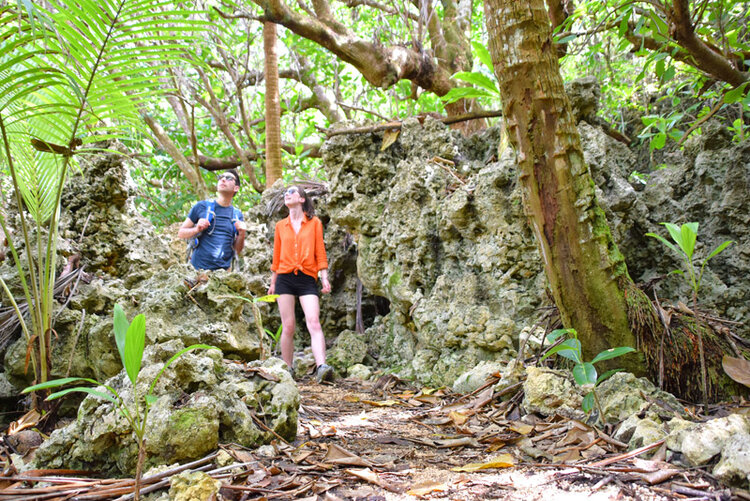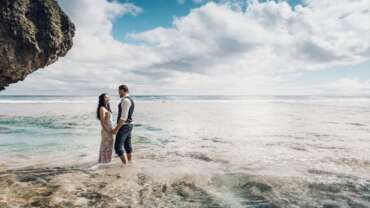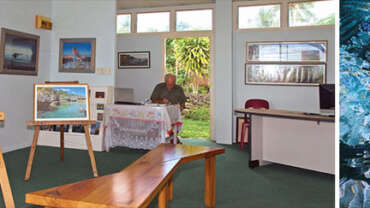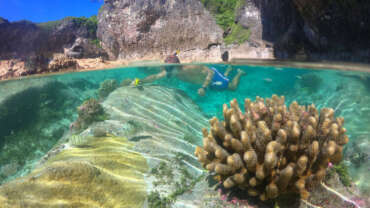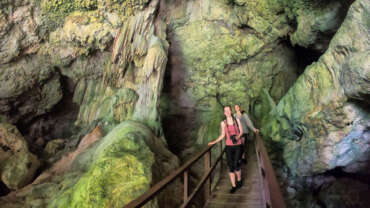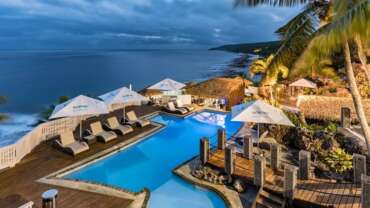Tracks & Walks in Niue
Dotted around the entire island are well signposted, well maintained tracks with a range of scenic walks. All tracks hold a very special surprise at the end – whether it be rain forest, jagged coral pinnacles, steep descents or spectacular caves, you will come across scenes that could feature in a movie set.
All fitness and adrenalin levels are catered for and guides can be arranged for bike, cave, bush and reef tours through the Niue Tourism Visitor Information Centre in Alofi… or you can safely explore most yourself.
Please note: due to damage from Tropical Cyclone Tino, in February 2020, some tracks may be closed or damaged. Please take extra care when on tracks and read the signs, fakaaue.
SCENIC AND HISTORICAL SITES
Niue’s coastline is adorned with unique geological landmarks, spectacular limestone formations and extensive cave systems. Many of Niue’s historical land marks and sites are clearly signposted and make for a great trip of self discovery on your visit to Niue. Local tour operators are also available for guided tours to places of interest.
REEF WALKS
Niue is ringed with a raised reef that at low tide can be safely explored; the clean waters, lack of industry and small human population ensure the coastline is exactly as nature created it, and it’s a fascinating trip.
Anapala (moderate)
Descending 155 steps into a well known chasm and pool of fresh water situated near the track leading from the village of Hakupu to the sea, Anapala was a main source of fresh water for residents of the surrounding village.
Avaiki (moderate)
A historical place in Niue as this was where the first canoe landed. It is advisable to visit Avaiki during a low tide as there is an amazing swimming cave to the north of the main cave and perfect for a sunset swim.
Limu (easy)
One of the most beautiful swimming and snorkelling areas on the northern coast of the island, the crystal clear waters of Limu hold a wide variety of fish life and caves to explore. The mixture of salt and fresh water flowing out from the island provides a refreshing and unique snorkelling experience. The track to Limu is clearly marked at the northern end of Namukulu Village and has wonderful picnic areas available. A visit to Limu is a must for all visitors to the island.
Hio (moderate)
Located just on the outskirt of Tuapa village heading north is a small secluded sandy cove. At low tide a cave to the north of the cove can be accessed. It was here that the Peruvian ‘black birder’ Irole wrecked in 1877, locals took possession of the liquor that was salvaged from the wreck and poured it into the sea despite the protests of the Captain.
Matapa Chasm (easy)
Noted for its expansive cliff face and historical importance as a reserved bathing place for Niue’s traditional kings, Matapa Chasm is reached by a track which branches off from the main road at the foot of Hikutavake Hill and beside the start of the trek to Talava Arches. Matapa Chasm provides a sheltered snorkelling, swimming place for all.
Opaahi (easy)
This was the site Captain Cook’s second landing attempts in June 1774. Cook’s landing party was challenged by the locals, who retreated after several volleys were fired, and the landing party returned to the ship.
Palaha (moderate)
Located south of Tuapa village, along the North West coast of the island, Palaha is notable for its limestone formations in varying shades of green and red. The reef flat is accessible at low tide, with small pools to snorkel in. The rock formations can get quite slippery so do navigate them with caution.
Peniamina’s Grave (easy)
Located in a small clearing on the left hand side of the road 5km north of Alofi is the burial site of Peniamina, the first Niuean to bring Christianity to the island. In his honour Niue also observes an annual public holiday in October.
Talava Arches (moderate – hard)
Branching off to the right of the access track to Matapa Chasm is a clearly marked trek to Talava Arches. Traditionally used as a lookout point to keep watch for impending raids or foreign vessels, Talava is now home to one of Niue’s unique land marks – the Arches.
Togo (moderate to hard)
Everyone should make at least one trip to Togo which is reached by a track starting about 4km north of Hakupu. After leaving the bush the track descends through a mass of jagged coral pinnacles to a grassy flat, where a passage leads off to the edge of a chasm. At the foot of the chasm there is a beach of fine golden sand from which some coconut trees rise, almost reaching to the rim of the chasm.
Tomb Point (easy)
An easy walk next to church in Alofi, opposite the main shopping centre and with a lookout and 180 degree views of the Alofi bay. There are picnic areas nearby and two of Niue’s former kings are buried within the grounds of the church.
Ulupaka (hard)
Located 800m south of Lakepa village is Ulupaka Cave which appears to have been used as a traditional dwelling place. It’s filled with a vast array of limestone formations – great clusters of stalactites and stalagmites, huge pillar formations where they have joined and giant stone curtains draped from the ceiling. This is a guided only trip as the cave is located on private land.
Uluvehi (easy)
1846 hailed the arrival of Christianity to the island through Peniamina. In 1863 Peruvian Slave traders arrived at Uluvehi and carried away 109 young Niuean men in 3 ships to work in the guano mines of Chile. None ever returned. Uluvehi was also used as a landing site by trading schooners. Today, Uluvehi offers a great view of the ocean and with a coconut stop at the start of the road it’s a great way to refresh yourself before continuing on with your journey.
Vaila (easy)
The rock pools of Vaila in Alofi North are a snorkeler’s delight and is also an access track into the Alofi North Marine Protected Area. The marine protected area is a ‘no-take’ area however visitors are welcome to use the picnic facilities.



